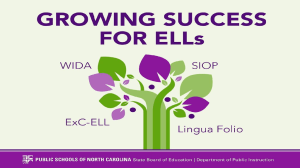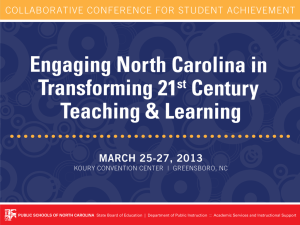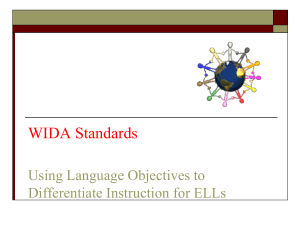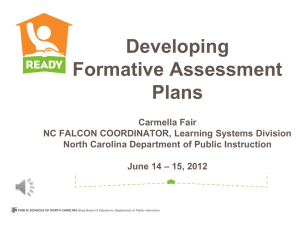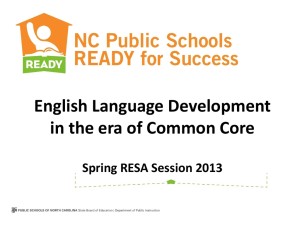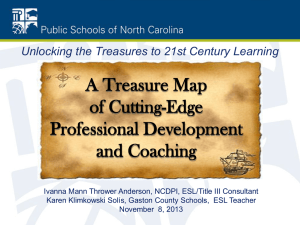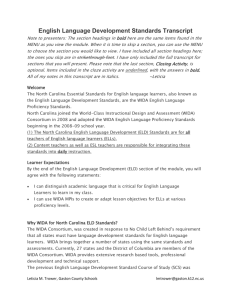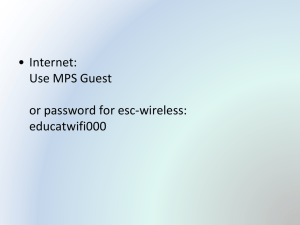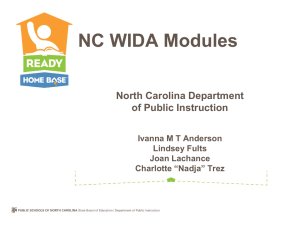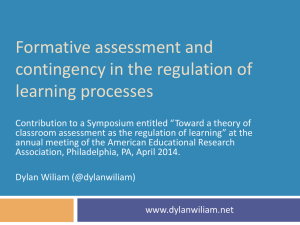RESA FALL 2014 (1)
advertisement
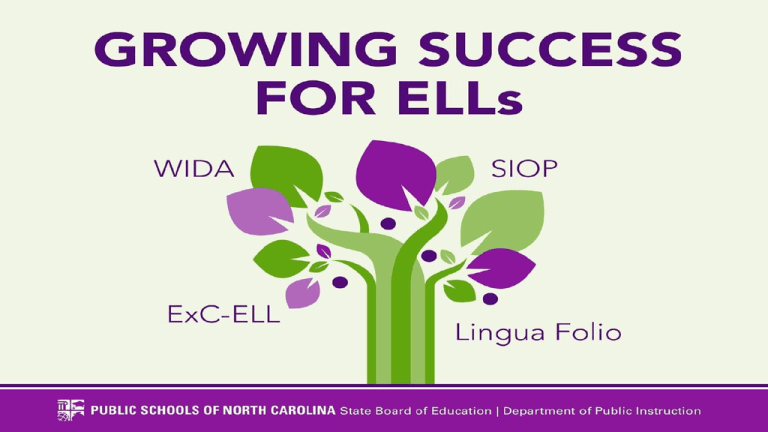
Introductions Lindsey Fults, ESL/Title III Consultant Lindsey.fults@dpi.nc.gov Nadja Trez, DPI Consultant nadja.trez@dpi.nc.gov Ivanna M.T Anderson Ivanna.thrower@dpi.nc.gov VISION: •Build capacity •Sustain statewide implementation •Meet the needs of our English Language Learners Inclusion Activity: Group Resume Each Group: •Will learn about individuals in the group by discussing the prompts •Pick a facilitator and a scribe to keep track of the discussion on chart paper •Prepare a 2-3 minute presentation that highlights the strengths/ interests of the entire group. – “How would you promote your group to others?” Today’s Objectives 1. Evaluate the elements of the WIDA ELD Standards with a focus on formative assessment 2. Interpret WIDA’s Guiding Principles of Language Development. 3. Develop formative assessments to authentically gauge academic language and content knowledge based on the MPIs that were created Logistics * restroom locations * break times * wifi passwords * group norms Today’s Agenda 8:30 – 9:00 am Sign in 9:00 – 10:30 Formative Assessment 10:30- 10:45 BREAK 10:45- 12: 00 Guiding Principles of WIDA 12:00 – 1:00 Lunch 1:00 -2:15 Develop content specific MPIs 2:30 – 2:45 BREAK 2:45- 4:00 Lesson Planning with Formative Assessment Formative Assessment: What Do Teachers Need to Know and Do? By Margaret Heritage •What types of assessments do you utilize? •What is formative assessment? •What are the elements of formative assessment? •What are the skills teachers need? Rank your WIDA knowledge level Survey “Questions” 1. I can explain the 6 language proficiency levels. 2. This is what I know about the WIDA performance definitions... 3. I can explain the differences among vocabulary usage, language forms & conventions, and linguistic complexity. 4. I can utilize WIDA standards to develop lesson plans. 5. I am able to develop MPIs for content standards based on students’ language proficiency levels 6. I can recognize whether WIDA standards are being utilized within instruction. WIDA ELD Standards So many layers to consider! WIDA’s Guiding Principles of Language Development Cards with one guiding principle each are on each table. Participant 1 reads the card. Participant 2 responds to the card. Participant 3 adds an additional response. Participant 4 summarizes what has been said. (Add additional responses before the summary as needed based on the number at your table.) WIDA Components * Proficiency Levels * Performance Definitions (old & new) * Vocabulary Usage, Linguistic Complexity, Language Forms and Conventions * Can Do Descriptors * Components of new MPIs in the 2012 handbook Proficiency Levels Performance Definitions At a given proficiency level, what the ELL student will process, understand, produce, or use. (Page RG44 in the 2007 Edition) New Performance Definitions Receptive Productive p. 8 in 2012 version p. 9 in 2012 version Speaking Rubric Found on p. RG-55 in the Resource Guide of the 2007 WIDA Standards handbook. This is the rubric that WAPT and ACCESS administrators should be utilizing to evaluate responses. Writing Rubric Found on page RG-56 in the 2007 WIDA Handbook Resource Guide. ACCESS writing domain is evaluated via this rubric. Upon Review of the Rubrics…. DISCUSS: 1. What is the purpose of the rubrics? 2. How are these useful and how do you use them in your districts? 3. What are the implications for ELLs? please discuss & then share out your table responses in a few minutes. Vocabulary Usage (Specificity of word or phrase choice) • • • • • General, specific, and technical language Multiple meanings of words and phrases Formulaic and idiomatic expressions Nuances and shades of meaning Collocations Linguistic Complexity vs Language Forms & Conventions DISCOURSE LEVEL Linguistic Complexity ★ ★ ★ ★ ★ * quality & variety of oral and written text amount of speech/written text structure of speech/written text density of speech/written text organization & cohesion of ideas variety of sentence types SENTENCE LEVEL Language Forms & Conventions * types, array, & use of language structures ★ types and variety of grammatical structures ★ conventions, mechanics, & fluency ★ match of language forms to purpose/perspective Can Do Descriptors • More specific to grade level than language performance definitions • Focus more on academic tasks • Detailed by language domain What are the instructional implications of utilizing the Can Do Descriptors? How do you use them? 2012 WIDA MPI Format (Overview) Our tool to optimize learning! How do we create an MPI? 3 components of an MPI * additional components from 2012 WIDA handbook What is transformation? (in relation to an MPI) As the name implies, transformation simply means to change or convert something. And in the case of MPIs, transformation occurs when we change one or more of its three elements: the language function, the content stem, or the instructional supports to make it specific to our own use within our own lessons. Examples of transformed MPIs http://www.livebinders.com/play/play?id=1089921&backur l=/shelf/my Links to the Standards: Math ELA Science Social Studies Process for Developing MPIs ALSO: Assessment & Feedback Practice & Application At your table discuss possible MPIs that could be created based on the following information & select 1 person from your table to share with the whole group. • • ELD Standard: Language of Science Content Standard: Explain why Earth sustains life while other planets do not based on their properties (including types of surface, atmosphere and gravitational force) and location to the Sun • • Cognitive Function: your choice Language Proficiency Level: Level 3 Work with a partner to develop a strand of MPIs. Links to NC Standards: Math Science ELA Social Studies Q&A FORMATIVE ASSESSMENT Construct a circle map that gathers what you know about formative assessment as a table group. monitors student learning formative assessment In your table groups, assign sections of the article, “WIDA Focus on Formative Assessment”, mark the text individually and share with your group after reading. Decide if this information should be added to your group’s circle map (in a different color). Share new/added info with the whole group. www.flareassessment.org Effective Use of Formative Assessment In order to use formative assessment effectively with ELLs, teachers must be cognizant of students’ needs in content area learning and language development. source: WestEd Laura Alvarez, Sri Ananda, Aida Walqui, Edynn Sato, Stanley Rabinowitz Examples of Formative Assessment Grades 1 - 3 Language Strand www.toondo.com Teaching Channel Link Teachers should help students ROAR by R - recognizing students as individuals O - providing different options (lesson delivery, output) A - adapting for students to access material R – providing resources We are all language teachers! “Focus on Language Learning Progressions” Read your section (assigned by table) of the article. 1. Decide as a table group the 3 most important ideas from your section. 2. Share these ideas (referencing the paragraph/ page #) with the whole group. Justify why your table considers these the most important ideas. What might you need to share or remind your district of from the article? Teachers don’t need more strategies, they need to know more about language acquisition & development. On-Line Training Modules • LinguaFolio training modules –Http://www.learnnc.org/lp/editions/linguafolio/ • The WIDA English Language Development Standards –http://www.rt3nc.org/ –Available to NC Teachers through HomeBase. Accessed by logging in with your existing username and password. Final Thoughts Schoolnet Resources Log into SchoolNet to find useful lesson plans. WIDA Lesson Plan Share Space Other lesson plans? References Developing Content Area Literacy, http://www.sagepub.com/upm-data/34121_Section1.pdf Fillmore, L. W., & Snow, C.E. (2002) What Teachers Need to Know about Language Francis, D.J., Lesaux, N., Kieffer, M., & Rivera, H. (2006). Practical Guidelines for the Education of English Language Learners. Lemke, J.L. (1990). Talking Science: Language, Learning, and Values. Scarcella, R. (2003). Academic English: A Conceptual Framework Sato, Edynn. Language for Achievement. http://www.cde.ca.gov/sp/el/er/documents/achievementlang.pdf Walqui, A. (2003). Conceptual Framework: Scaffolding for English Learners. Zwiers, Jeff. Academic Language and Literacy. http://www.jeffzwiers.org/index.html Linguafolio self-assessmenthttp://esllfpilot.pbworks.com/f/LFGridNCES.pdf students talking about pros and cons of “Book It” program by Pizza Hut https://novoed.com/common-core/video_list_lecture_components/2998/lecture_videos/1425 link to teacher demonstrating how he goes from a persuasive essay to brochure: https://www.teachingchannel.org/blog/2014/05/23/support-structures-that-help-teachers/ link to teacher implementing sentence frames, textual evidence in ELA lesson: https://www.teachingchannel.org/videos/ap-english-lesson-plan Our Vision •As Dr. Robin McCoy has stated, our vision is to build capacity at the local school system level and sustain statewide implementation of research-based strategies to meet the needs of our English learners. Thank you for being part of this journey and helping make the vision a reality! Evaluation •Please complete online the evaluation form.

